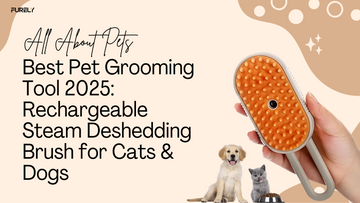
Dog Bath:
Dog Bath is an important aspect of pet care. Not only does a clean dog feel happier, being clean is also better for his health. Taking regular baths will help remove the dirt, debris, and allergens present in their coat, minimizing the chances of allergies and skin infections. Many pet owners, however, find themselves working through the process — not sure how often to bathe their dogs or what products to use. This guide will walk you through what you need to know to give your dog a proper bathe.
Why is it important to bath dogs?
Dogs are natural outdoor creatures who get dirty easy. From rolling in the grass to playing in the mud to simply shedding natural oils, dogs need frequent baths in order to stay fresh. Bathing keeps dirt, bacteria and odor at bay while also making your furry little buddy feel nice and comfortable! It also keeps shedding in check, minimizes allergens, and prevents parasite-related infections, including those that cause fleas and ticks.
How Often Can You Bathe Your Dog?
How often to bath your dog — breed, coat type and lifestyle. Depending on the dog, you may need to bathe them more frequently than others; some dogs can go up to weeks without a bath. Here are general guidelines:
Short haired dogs (Labradors, Beagles) -- once in 4-6 weeks
Long-haired dogs (Golden Retrievers, Afghan Hounds) may require a bath every 3-4 weeks to prevent matting.
Dogs showing signs of skin conditions may need medicated baths on their vet’s advice.
Active dogs who enjoy some nature might need more baths.
Just make sure you are not washing your dog too often, as washing too much can strip natural oils from their coat and dry out their skin.
How to Choose the Best Shampoo for Your Dog
Not all shampoos are made the same way, though, and using the wrong kind can have damaging effects on your dog’s skin and coat. Tips to Choose the Best Shampoo:
Mild, natural ingredients: Choose shampoos free of harsh chemicals and of natural, soothing ingredients as oatmeal, aloe vera or chamomile.
Hypoallergenic: Opt for a hypoallergenic shampoo if your dog has sensitive skin that could result in an allergic reaction.
Flea and tick shampoos: Dogs who have a tendency to get fleas and ticks benefit from a medicated shampoo for parasite control.
pH-balanced formulas: Human shampoos tend to be too acidic for dogs, so always select a shampoo that’s made for canine skin.
How to Bathe a Dog: A Step-by-Step Guide
Gather Your Supplies
To get started, take the time to assemble what you will need:
Dog shampoo
Towels
A non-slip mat (if you’re using a bath tub)
A cup or handheld sprayer
Treats (to reward your dog)
Brush Your Dog
Brushing before bathing removes the loose hair and tangles, making it easier for you to wash and rinse your dog. It also works to clean away dirt before water hits the coat.
Prepare the Bath Area
Depending on the size of your pet, fill up your tub or sink with lukewarm water. Taking a bath with too high or too low temperature can cause discomfort for your dog. When washing your dog in the yard, be sure the water pressure isn’t too powerful.
Wet Your Dog’s Coat
Soak their coat with a sprayer or a cup. Avoid the ears and eyes to not cause irritation.
Apply Shampoo and Lather
Apply the shampoo all over your dog’s coat, rubbing it gently to build up a good lather. But the paws and underbelly are where it gets dirtier, so pay special attention to those areas.
Rinse Thoroughly
Give your dog some clean water so all the shampoo is rinsed from his coat. Residue can irritate the skin, so be sure to rinse thoroughly.
Dry Your Dog
Wipe off the excess water with a towel. If your dog can handle it, you can run a pet friendly hair dryer on a low setting. Make sure the dog is thoroughly dry, especially in cooler weather.
Helpful Tips for Stress Free Bathing
Keep it fun: Give treats and a positive tone.
Start young Puppies adjust to being bathed easier when they start young.
Be patient: Some canines might be nervous, move slowly and give them reassurance.
Use a bath mat: To minimize slipping and help your dog feel stable.
Make sure that you clean the ears separately: You must ensure that not get water inside ears as it can lead to infections.
An Option for Old-Fashioned Bathing
If your pup hates baths, here are some alternatives:
Waterless shampoos : Spray or foam-based products that do not require water.
Dog wipes: Good for spot-cleaning between baths.
Professional grooming – If you aren’t able to bathe your dog comfortably yourself, groomers take care of this task quickly and efficiently.
Final T houghts
Bathing your dog is an important part of their grooming routine, helping them to stay clean, comfortable and healthy. With a few considerations around product selection, bathing routine and making it enjoyable, you can ensure your dog is happy and fresh. Bathing your dog regularly not only enhances his hygiene but also helps in strengthening the bond between you and your pet. Bath time can be a pleasant experience for both of you with a little patience and care.
Furely will be back with the next blog soon; till then, stay tuned!








